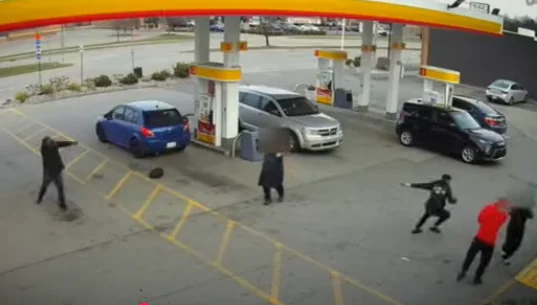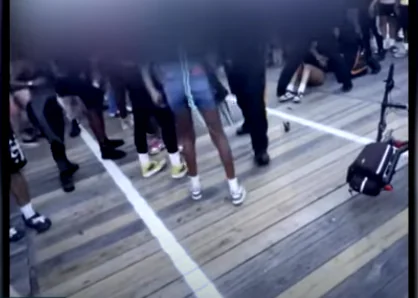The Decline of Detroit: A City in Crisis
Detroit was once a city that symbolized American innovation and prosperity, a beacon of industrial power and economic success. Known as the heart of the automotive industry, Detroit was not only a hub for manufacturing but also an attractive place for businesses, offering abundant opportunities. The city was a thriving metropolis, brimming with life, culture, and potential.
However, over the years, Detroit underwent a dramatic transformation. Today, it stands as one of the most recognizable cities in America for its rampant crime, poverty, and abandoned neighborhoods.

The Rise and Fall of Detroit
Detroit’s industrial boom began in the early 20th century, earning the city a reputation as the Motor City. Major automotive manufacturers like Ford, General Motors, and Chrysler established their headquarters in Detroit, making the city the global epicenter of automobile production. Along with this success came immense growth, with people flocking from all over the country to find jobs in the factories that powered the nation’s economy.
Detroit was a city of opportunity, offering not only jobs but a lifestyle that many in America aspired to. The city became a symbol of what the American Dream could look like, with prosperous neighborhoods, strong schools, and a booming middle class.
However, the seeds of Detroit’s decline were planted long before the city’s eventual downfall. As the automotive industry began to face challenges in the latter half of the 20th century, including foreign competition and rising production costs, the city started to lose its economic grip. The gradual decline of the automobile sector led to a series of factory closures, and jobs that were once plentiful became increasingly scarce. With fewer employment opportunities, Detroit’s middle class started to leave, migrating to the suburbs in search of better living conditions.
The Impact of the Recession
The 2008 recession marked a pivotal moment in Detroit’s history. As the city’s economy was already on shaky ground, the collapse of the housing market exacerbated the situation. Detroit was hit particularly hard, with thousands losing their homes and businesses folding under the weight of an economic crisis. Schools began closing, and public services were slashed, creating a perfect storm for an already struggling city.
Around this time, a series of public projects were supposed to revitalize the city. For example, the Brewster projects, one of Detroit’s most prominent inner-city areas, was slated for a $300 million redevelopment. Plans were drawn, and images of sleek new buildings and modernized spaces were circulated, but the project never came to fruition.
Instead, the city sold the land to a private investor, Dan Gilbert, the owner of Rocket Mortgage, for $27 billion. Such instances of misallocated funds were not isolated—rather, they became a common thread in Detroit’s unraveling.
With the city’s resources drying up, those who remained faced a harsh reality. Jobs were scarce, schools were underfunded, and neighborhoods once full of life now stood abandoned, with empty buildings and overgrown lots serving as constant reminders of Detroit’s former glory.
As poverty deepened, crime surged. Detroit became infamous for its high crime rates, consistently ranking among the most dangerous cities in America for decades. The violence that plagued the city was not only the result of poverty but also the lack of organized systems to address the growing crisis.
The Surge in Violence
Detroit’s rise to prominence in the 20th century was mirrored by a dramatic rise in violence in the 21st century. Historically, Detroit was known for organized crime, particularly during the 1960s and 1970s, when the city was gripped by mob influence. The infamous Detroit riots of 1967 were a tragic chapter in the city’s history, with widespread violence and looting breaking out after tensions between African American residents and the police escalated. The mobs that controlled the city’s crime scene had structure, and their illegal activities were largely controlled.
Today, however, the nature of Detroit’s crime has shifted. Instead of organized criminal syndicates, the city now faces random, senseless violence. Shootings are more common, and incidents of drive-by shootings or mass shootings have become a grim reality.
Many of these violent events are fueled by a combination of factors: the proliferation of illegal firearms, the lack of economic opportunities, and the absence of community support systems. Innocent bystanders, including children, have become victims of this violence, which further erodes the sense of safety in the city.
A Divided City: Wealth vs. Poverty
One of the most significant challenges Detroit faces is the stark contrast between its wealthy and impoverished neighborhoods. While parts of the city have seen gentrification and redevelopment, much of the money that could revitalize Detroit’s struggling areas has been funneled into more affluent parts of the city. This selective investment has deepened the divide, with certain areas flourishing while others continue to crumble.
The city’s efforts to clean up its image have been apparent in some parts, such as downtown Detroit, where new housing developments and commercial spaces have sprung up. However, these improvements have not reached the heart of Detroit’s poorest neighborhoods, where vacant homes and abandoned schools remain a constant presence. The lack of investment in these areas has led to a cycle of poverty and violence that is difficult to break.
Looking to the Future
As Detroit emerges from bankruptcy and begins to rebuild its financial reserves, the city faces a critical question: how can it balance the need for revitalization with the need to address the systemic issues that plague its most vulnerable communities? The new mayor of Detroit, elected in the coming months, will play a crucial role in determining the city’s future. For the first time in years, Detroit has the resources to make a significant change, but it will require careful planning and a commitment to equitable development that reaches all areas of the city.
Detroit’s story is one of both triumph and tragedy. While it was once a model of industrial success, the city’s decline serves as a warning about the dangers of economic instability, the failure to invest in all of a city’s people, and the consequences of neglecting the areas most in need. For Detroit to rise again, it will require more than just financial investment; it will need a transformation of its systems, its communities, and its spirit. Only then can the Motor City hope to regain the pride and promise it once embodied.









